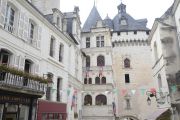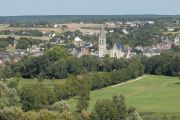 |
 |
Loches, former royal residence |
 |
Peaceful and charming town of southern Touraine, Loches is steeped in history and boasts a rich architectural heritage. An enjoyable destination for couples and families alike.
[ Practical ]
Getting there
- By road
250 km from Paris on autoroute A10 till Tours, then on D943 till Loches.
- By train
TGV from Paris Montparnasse to Tours or Intercités from Paris Austerlitz to Tours. The journey takes 1 h or 2 h 15.
TER train or bus from Tours to Loches. The journey takes 1 h.
Lodging
- Hotels
Hôtel de France
Pierre et Vacances Le Moulin des Cordeliers
- Bed and breakfast
La Closerie Saint Jacques
Le Presbytère
Demeure Saint-Ours
Loch’House
Les Troglos de Beaulieu
Restaurants
Le P’tit restau
Le George Sand
La Gerbe d’Or
Information
- Office de Tourisme de Loches
Ph : 0247918282
www.loches-valdeloire.com
Missing the medieval city of Loches is impossible. Perched on a rocky spur overlooking the Indre Valley, where fords once allowed to cross the river, it is seen from afar with its mighty rectangular keep, its church’s spires and its castle outlined against the sky.
Often described as the gateway to southern Touraine, this lovely town is also dotted with beautiful buildings dating from the Renaissance. Despite this rich heritage and boasting one of the so-called castles of the Loire valley, it remains untouched by mass tourism and maintains a peaceful atmosphere even in summer. An extra reason to spend a day or a weekend there.
 Walled upper town Walled upper town
The best is to start your visit with the upper town that because of its strategic position was in the Middle Age encircled by a two km long wall still visible and well preserved. The only access is through the impressive Royal Gate, built from the 13th to the 15th centuries and flanked by two towers with machicolation. Once inside, if there are few tourists, you will find yourself immersed in a quiet and muted universe where the few streets are lined with high walls behind which are hidden gardens and opulent houses belonging to the local bourgeoisie.
To see them, there is only one solution, to climb to the top of the massive 37 m high rectangular keep that stands at the southern end of the rocky spur. From there you will also discover the lower town and, in the distance, the abbey of Beaulieu-les-Loches. Masterpiece of medieval military architecture, one of the best preserved in Europe, this keep was built in the eleventh century by order of one of France’s most powerful nobleman, the Count of Anjou, Foulques Nerra.
 Ominous dungeons Ominous dungeons
Subject of fierce battles between French and English troops at the beginning of the Hundred Years War, it was then converted into a state prison by King Louis XI. A visit to its dungeons gives an idea of the conditions of detention at the time and some cells are adorned with graffiti and drawings left by prisoners. A few of them were produced by Ludovic Forza, duke of Milan, who was jailed for opposing Kings of France’s plans to conquer northern Italy. Known to have been the first patron of Leonardo da Vinci to whom he commissioned the Last Supper, he died in town in 1508 while the artist passed away in 1519 in Amboise, less than 40 km away.
From the fourteenth to the sixteenth centuries and especially during the Hundred Years War, a number of French kings stayed in Loches for shorter or longer periods of time. They lived at the other end of the upper town in what is now called the Logis Royal.
 Castle built in two stages Castle built in two stages
It was there that Joan of Arc came to meet King Charles VII to convince him to go to be crowned at Reims. The first part of this castle was built in the medieval style in the fourteen century by order of Charles V. Hence the large round tower which served as watchtower standing on one of its corner, the four turrets and the walkway. Then, in the late fifteenth and early fifteenth century, under the reigns of Charles VIII and Louis XII, a Gothic and Renaissance style extension with a residential function was added.
The interior is mostly composed of large medieval rooms with a sober style nowadays decorated with Flemish tapestries as well as some furniture and armours. One of them also contains a beautiful altarpiece, a work by a member of the school of painter Jehan Fouquet. However, there is an exception to this architectural simplicity, a delightful flamboyant gothic style oratory that was made for Queen Anne of Brittany.

 Collegiate Saint Ours © T.Joly Collegiate Saint Ours © T.Joly
|
 Unusual church Unusual church
One of two famous women to have lived in the castle with Agnès Sorel, mistress of King Charles VII, the first in history to have had an official status. She rests in peace in a grave featuring a superb recumbent statue in the nearby collegiate Saint Ours. A Romanesque church with an unusual architecture, its nave being topped with two pyramidal cupolas called dubes.
If you are an art lover, do not leave the neighbourhood without taking a look at the Emmanuel Lansyer's house and museum, a pupil of Gustave Courbet, considered one of the best landscape painters of the 19th century. It presents a selection of his works, particularly views of Brittany as well as of Rome and Venice where he travelled several times and from where he brought back works of major Italian artists.
It is not the only artistic connection between Loches and this country.

 City hall and Picois Gate © T.Joly City hall and Picois Gate © T.Joly
|
 Renaissance buildings Renaissance buildings
In the lower town, in the Antonine Gallery you can admire two canvases by Caravaggio bought by a nobleman of the region, Cardinal Philippe de Béthune who served as ambassador to Rome in the seventeen century.
This part of town also boasts several worthy Renaissance buildings built under the reign of Francis I. The Saint-Antoine Tower, formerly a steeple and a belfry, the town hall, the Centaur’s House that gets its name from a carving adorning its facade and a former private mansion called the Chancellery which houses a small exhibition about the history of Loches. Most of these buildings are along or in the vicinity of rue du Château and Grande Rue where you will find a large choice of bars and restaurants. Lastly, there are two remains of the rampart built in the fifteenth century to protect the lower town. The Picois Gate next to the town hall and the Porte des Cordeliers facing the bridge spanning the Indre.

 Beaulieu-les-Loches © T.Joly Beaulieu-les-Loches © T.Joly
|
 Village with the charm of yesteryear Village with the charm of yesteryear
After crossing the river, take a stroll in the pretty public garden extending on its right bank. It offers the best view of the castle and the collegiate Saint Ours. Made of tufa, stone used to build many mansions and castles of the Loire Valley, the rocky spur dominated by the medieval city is punctuated with many man made cavities including the old underground quarry of Vignemont where 750 m of its 4 km of galleries can be visited. Nearby, there are still some troglodyte dwellings and even a troglodyte trattoria named Mauvières located further away. If you want to experience sleeping in such a place, one has been turned into a bed and breakfast in Beaulieu-les-Loches. Only 2 km away and easily accessible on foot, this village deserves to be visited if you spend more than a day in Loches because it retains its character of yesteryear. Stretching around the remains of an abbey founded in the 11th century by Foulques Nerra who rests there, it boasts two beautiful churches and many old houses.
August 24, 2019
Thierry Joly 

|
|
 |

|
 |



